Lecture
Who invented the electronic digital computer? Until the early 1970s, it was easy to answer this question — these were John Mauchly and John P. Eckert, who in 1943-1946 created ENIAC, a functioning electronic digital computer. But after October 1973, by the court’s decision, John V. Atanasov was named the inventor of the electronic computer. Ironically, Atanasov, a physicist from Iowa, who invented a computer in the late 1930s, was better known in Europe than in America.
American scientists and engineers who created electronic computers in the 1940s and 1950s knew little about it. Nevertheless, in the early 70s Atanasov won the legal right to be called the inventor of an electronic computer. Mauchly and Eckert stated that the trial was unfair, that Atanasov’s computer never worked and that they were the inventors of the electronic computer. Most scientists now believe that the issue of priority is still not resolved and, ultimately, of little interest. What can be said with certainty is that Atanasov, Berry, Mauchli and Eckert made a significant contribution to the development of an electronic computer.
Clifford berry
Mathematics has been the center of interest of John Vincent Atanasoff since childhood. He was born in Hamilton, New York, on October 4, 1903. His father, a Bulgarian émigré, was an electrical engineer, and his mother, an American, was a teacher and studied algebra for up to ninety years. When John was a child, his family moved to Florida after his father got an engineer job there. John was developed beyond his years. With the help of his mother, he learned to read early and loved everything he could learn from books.
In 1913, when he was 9 years old, John Atanasov began his journey into the electric world. His father, who ran a phosphate mine electrical system, conducted electrical wiring in his home, making it one of the first in the district. Thanks to senior Atanasov, John learned the basics of electricity. That same year, his father bought a slide rule for John, and from February to August, John worked with logarithms using the textbook by J. M. Taylor for colleges, which he obtained from his father’s library.
At the age of 10 he studied physics and chemistry, and also continued to study mathematics. His mother gave him a book that explained how to make calculations in other number systems other than decimal. Atanasov later recalled: “When I started working on a computer, one of the things that was spinning in my brain was that computers might work better with a different basis than ten.”
While studying at school, Atanasov decided to become a theoretical physicist, but, having entered the University of Florida in 1921, he chose the profession of an electrical engineer. He received an engineering degree in 1925. In September of the same year, Atanasov went north to Iowa State College to teach mathematics and supervise graduate studies in physics and mathematics. Then Atanasov moved to the University of Wisconsin, where in May 1930 he defended his doctoral dissertation. Upon his return to Iowa State College, he is working as an assistant professor of mathematics and physics.
In the mid-1930s, Atanasov reflected on the problem of automating the solution of large systems of linear algebraic equations. Analog methods of solution using the Vannevar – Bush differential analyzer did not satisfy him due to insufficient accuracy, and devices that implement the digital approach did not exist. He tried to modify the IBM calculator to solve systems of equations, but due to the complexity of the work he soon refused (I must say that he was aware of the design of the analytical machine by C. Babbage).
The ideas and principles of creating a digital computer came to him, he recalls, in the winter evening of 1937 in a roadside tavern. In later years, he formulated the essence of these principles: in his work the computer will use electricity and the achievements of electronics:
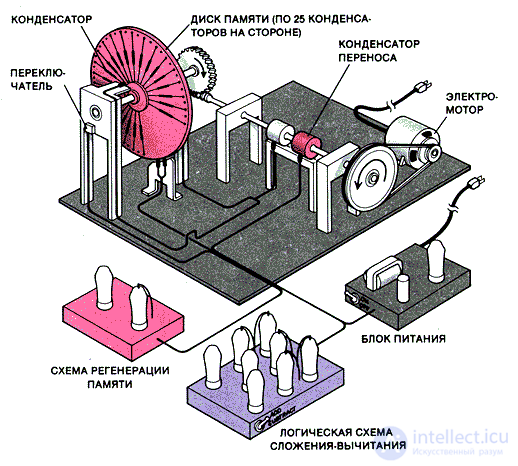
Прототип компьютера "АВС" был построен в 1939 г. с целью проверить две основные идеи. Атанасов намеревался постоянно перезаряжать, или регенерировать, конденсаторы памяти, чтобы они не теряли заряд непредсказуемым образом. Он также намеревался проводить вычисления посредством логических схем - набора электронных ламп, который складывает или вычитает двоичные числа в соответствии с логическими правилами, а не прямым подсчетом. Прототип оказался успешным. При повороте диска памяти (розовое колесо), на каждой стороне которого конденсаторы хранили по одному 25-разрядному двоичному числу, одна логическая схема (внизу посередине) складывала или вычитала числа, записанные в памяти на противоположных сторонах диска. Одновременно с тем, как логическая схема выполняла вычисления над очередным разрядом чисел (запоминая в процессе разряд переноса или заема или считывая его из конденсатора переноса), схема регенерации (слева внизу) обновляла содержимое памяти.
To implement the project he needed a talented inventor who knew electronics very well. Atanasov appealed to the dean of the Faculty of Engineering with a request to recommend him a graduate of the Electrical Engineering Department, who knows electronics well. Not a moment's hesitation, the dean offered him Clifford Edward Berry, a brilliant, hardworking, promising scientist who already has an impressive list of awards and achievements.
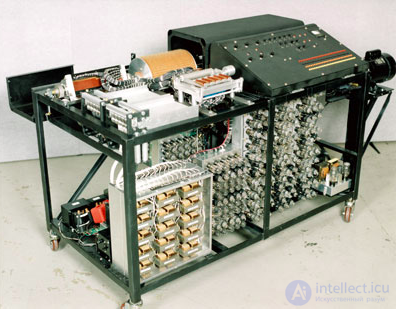

Компьютер Атанасова-Берри ("АВС") Общий вид компьютера Атонасова- Берри
Computer Atanasova-Berry ("ABC")
They met, and the team Atanasov and Berry was born, and in November 1939 the sketches of the computer Atanasov - Berry - ABC appeared (Atanasoff - Berry Computer, as later Atanasov insisted on being called that). The design and construction of the computer was carried out from the end of 1939 until the middle of 1942. What was the ABC computer? Here is what Clifford Berry R. Richards writes about this in a letter dated April 30, 1963: “The machine was designed for the sole purpose, namely, to solve large systems of linear algebraic equations (up to 30 × 30).
It uses binary arithmetic, the word length was 50 bits. The main solution method (Gauss method) was to successively exclude coefficients from pairs of equations in order to reduce the initial square matrix to a triangular one. Since the internal memory of the computer simultaneously saved the coefficients of the two equations, the intermediate results (that is, the unified equations resulting from a linear combination of two to reduce the number of variables by one) were stored on special punched cards, each of which contained thirty-50-bit binary numbers.
These punched cards were then read by the machine again at a later stage of the procedure. The punched card was punched or read for one second, but it had to be inserted manually.
The maximum time it took for the worst case machine to eliminate the variable between the two equations was about 90 seconds, and on average much less.
The machine consisted of two storage devices — one for the coefficients of each of the pairs of combined equations. These memories consisted of rotating drums, with small capacitors attached, each of which capacitors connected to a small brass contact on the surface of the drum.
Five-sixths of the peripheral surface of the drum were occupied by these contacts (30 rows of 50 contacts each), and the sixth part remained empty, providing time for other operations. The drums were driven by a synchronous gear motor that provides a speed of 1 rpm. Thus, the speed of the contacts past the reading brush was 60 per second.
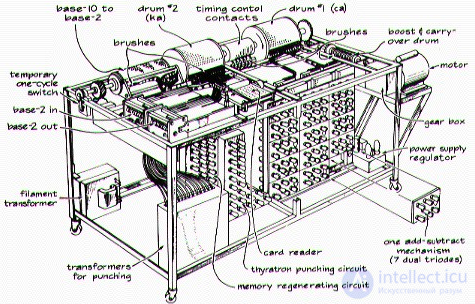
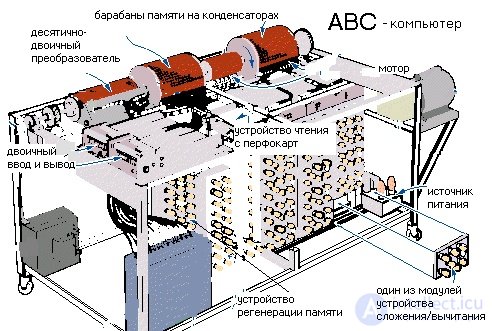
The polarity of the charge on the capacitor indicated “one” or “zero”, and each capacitor was recharged immediately after reading, so that the charge never remained on it for more than one second. All words were processed in parallel, but within each word the numbers were processed sequentially. It is interesting to note that before designing the memory on capacitors, we seriously considered the idea of using magnetic drums, but abandoned it because of the low level of signals.
There were 30 identical arithmetic devices that were essentially binary accumulators. Each consisted of a series of direct coupled electrovacuum lamps (seven dual triodes) interconnected in such a way that they performed binary addition. Each device had three inputs (two for the added or subtracted numbers and one for transfer from the previous place) and two outputs (one for the result at that place, and the other for transfer to another place).
The initial data entry into the machine was carried out using TEL cards, which were read by a special device of the described construction. Each card had five 15-bit decimal numbers that were read in 15 seconds. The machine converted decimal numbers into binary using a rotating drum (in the rear left corner of the machine), on which were located the contacts representing binary equivalents 1,2 - 9,10,20 - 9х14. At the output for the inverse transformation, the same apparatus was used in the reverse order and a decimal result appeared on the mechanical counter ”.
And further, Clifford Berry writes that “the only major node that was not completed by the time of the termination of work in the middle of 1942 was the reading scheme for binary cards. The main computing part of the machine was completed and worked for over a year, but there was little use for it without the means to store intermediate results. ”
Atanasov's first meeting with John Mauchly, a physicist at Ursinu-sa College, in Pennsylvania, occurred in December 1940, when Atanasov was still working on improving ABC. Both of these people attended the meeting of the American Association for the Advancement of Science in the University of Pennsylvania. Mauchly delivered a lecture on the possibility of using analog computers to solve meteorological problems; he discussed the use of a harmonic analyzer, which he built when studying certain weather phenomena. Atanasov was in the audience.
After waiting for everyone else to talk to Mauchli after the lecture, Atanasov introduced himself as someone interested in computers, especially a digital computer. He later told Mauchly about his unfinished machine, a computer using vacuum tubes, and that they might have a big impact on digital computers. Atanasov invited Mauchly to come to Iowa to see ABC.
Mauchly accepted the invitation on June 14, 1941. He and his son were in the house of Atanasov, stayed for the next 5 days, during this time two men talked endlessly about computers. Mauchly reviewed the documentation, and Berry gave a brief ABC demonstration. The machine could solve 29. Simultaneous equations with 29 variables.
Mauchly asked for one copy of the documentation home, but Atanasov refused. Three months later, in September 1941, Mauchli wrote to Atanasov a letter in which he asked whether it would be possible to build one Atanasov Calculator at the Moore School of Engineering at the University of Pennsylvania. Responding on October 7, Atanasov said that he wanted ABC to remain secret, at least until the patent application was filed.
The Second World War forced Atanasov to move away from the construction of computers. In 1942, he became head of the Department of Acoustics at the Naval Artillery Laboratory (NOL) in Washington, Columbia, where he monitored the acoustic testing of mines. One of the ABC parts, the arithmetic part, was tested in 1942 and gave Atanasov confidence that the computer project was largely completed. But ABC was never actually used.
John Mauchly, working part-time as a statistician in the same department, told Atanasov in 1943 that he and Eckert had developed a new approach to computing that was different from what Atanasov had suggested. Atanasov asked Mauchli to explain what he did, but received a sharp response. "I cant. Secret topic. ” The “new approach” was associated with ENIAC - the first fully electronic digital computer, which at that time was assembled under strict secrecy for military purposes at the University of Pennsylvania.
In 1945, the Artillery Department asked Atanasov to help in the design of a computer for the Naval Artillery Laboratory, while providing a large financial support. Atanasov said that he could not simultaneously work on a computer project and finish work in the Department of Acoustics NOL. The Navy ultimately refused its services.
One of the reasons was the report presented by the project consultant John von Neumann, who wrote that Atanasov was not competent to manage a project of this magnitude. Atanasov did not return to computers after the end of the war. “I have been working on computers for about 12 years and under very difficult circumstances. I needed a change of life. ” Years later, he regretted that he had abandoned his efforts to create a computer, but he realized this only when it became obvious that his car was truly revolutionary. In the early 80s, he admitted that if he understood the potential capabilities of ABC, he would continue to work on it.
Atanasov remained the head of the NOL Acoustics Department until 1949, and then became the chief scientist of the army field forces at Fort Monroe in Virginia. During 1950–1951, he was director of the NOL explosions program. In 1952, Atanasov founded the company “Artillery Engineering Corporation” in the city of Frederick, Maryland, and 4 years later sold it to the Air General Corporation of the same city. He became the vice president of the last firm, as well as the manager of its Atlantic division until 1961.
In the future, Atanasov worked as an automation consultant in a packaging company. He organized a company called “United Cybernetics” in the same city of Frederick, which gave advice of a semi-scientific nature. Atanasov had three children: a son, John Junior, and daughters, Elsie and Joanna.
Atanasov’s decision to prove that he is the inventor of an electronic digital computer came to him after one “strange” visit. On July 15, 1954, a lawyer from the IBM patent office visited Atanasov and told him: “If you help us, we will revoke the Mauchli-Eckert patent on a computer. It was borrowed from you. ” A short conversation between Mauchly and Atanasov in 1943, when the ENIAC project was already created, the lawyer presented in a different light, and Atanasov was convinced that he was right.
In fact, it was in the interests of large computer companies, not only to annul the Mauchly-Eckert patent, but also to disclose Atanasov's ABC in order to ensure the reliability of the patent field for its computer projects. The death of Clifford Berry in 1963 removed from the stage the person who is most capable of confirming Atanasov’s claim. Nevertheless, Atanasov was increasingly convinced that ENIAC was borrowed from his ABC and that it was worthwhile to continue this business. Moreover, he was given strength by the recognition of his merits in other countries, in particular in the homeland of his ancestors - Bulgaria, which in 1970 awarded him the Order of Cyril and Methodius I degree.
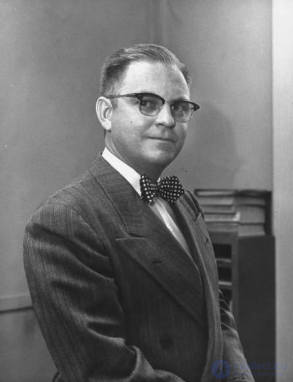
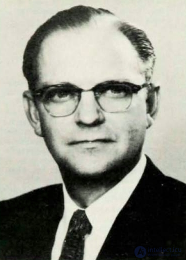
It came to court. In 1971, Sperry Rand, which acquired the Mauchly-Eckert patent for ENIAC, sued Honeywell for tax evasion. Honeywell filed a counterclaim, claiming that ENIAC was borrowed from a previously created ABC and that the patent was therefore invalid. To prepare his testimony in this case, Atanasov and his lawyers tracked down former colleagues and asked him to reconstruct the ABC. At trial, Atanasov showed exactly how ABC worked, pushing buttons, forcing light bulbs to light up. That was enough to impress Judge Airl R. Larson, who decided the case in favor of Atanasoff. The decision was announced on October 19, 1973, the day before the Watergate scandal, and therefore was lost in the newspaper hype.
The verdict really described Atanasov as the inventor of the electronic computer, and ENIAC - as the computer created to a greater extent on his idea. “Eckert and Mauchly,” Judge Larson read, “did not themselves invent this automatic electronic digital computer, but instead borrowed this idea from Dr. John V. Atanasoff, and therefore the ENIAC patent is invalid.”
The verdict outside the court was considered by many to be unfair and definitely confusing. Atanasov is bitter that he did not receive an award for his merits, which, he believed, deserved. In 1975, he had a stroke, but he recovered and lived the rest of his life on his farm near Monrovil, Maryland, in the house for which he designed the air conditioning system, kitchen cupboards, rainwater taps, 800-pound revolving front door and closed heating system. Those who stated that ABC did not work, Atanasov replied: “For me, the achievement is the ideas put forward. As soon as you get ideas, anyone can take advantage of them. ” John Vincent Atanasov died on June 15, 1995 at the age of 92.
If we know quite a lot about the life and work of John Atanasov, then there is only a few references to his co-author Clifford E. Berry in the Russian literature as Dr. Atanasov's graduate student, although his role in creating an ABC computer is significant. Atanasov himself confirmed this many years later: “I believe that the participation of Clifford E. Berry is one of the most important conditions for the success of our project.”
Information about the life and scientific activities of C. E. Berry is scarce: these are the memories of his wife, Gene Berry, the correspondence with R. Richards, and the memories of R. Meder, who helped Berry in the design of ABC.
Cliff (as many called him) Berry was born in 1918. He graduated from high school Marengo (Iowa) in 1934. Так как он был очень юн, родители считали, что ему следует подождать год, прежде чем поступать в колледж. Клифф посвятил этот год изучению наук и конструированию радиоприемника. Он был помощником начальника отряда бойскаутов, любил классическую музыку.
По финансовым причинам его овдовевшая мать переехала в Эймс, чтобы все четверо детей могли посещать колледж Айова. Клифф зарабатывал деньги на свое обучение в колледже, работая на фирме “Гулливер Электрик”, и несмотря на эту дополнительную работу он имел чрезвычайно высокие успехи в учебе и был избран в четыре почетных общества — Сигма Кси, Эта Каппа Ню, Фи Каппа Фи и Пи Мю Эпсилон.
На первом году обучения ему была присвоена специальная награда за лучший академический доклад на отделении электротехники за первый и второй курсы. Клифф окончил колледж в 1939 году и начал работу над диссертацией по физике и математике, а также занимался компьютером, который позднее был назван ABC.
В 1941 году он получил степень магистра по физике. Его диссертация была посвящена одному из устройств компьютера ABC и называлась “Конструкция электрических механизмов записи и считывания данных”. В этой диссертации Берри писал: “Настоящая работа проводилась совместно с разработкой быстродействующей вычислительной машины…
In order to maximally realize high-speed calculations on a computer, it is necessary to write and read numbers on cards with a speed of about 60 holes per second. This seems simply unrealistic in practice for conventional mechanical methods, so we developed the method described below that meets the requirements. ”
В мае 1942 года Клифф женился, а через месяц супруги уехали из Эймса (теперь становится ясным, почему работы по созданию компьютера ABC были прекращены в 1942 году — уехал главный конструктор). Его ждала работа в Пасадена на фирме “Консолидейтед Индженииринг Корпорейшн”. Он почти закончил работу над диссертацией на степень доктора философии по физике, но не возобновил над ней работу до конца Второй мировой войны. С самого начала он сделал молниеносную карьеру. Он писал технические статьи, патенты и внутрифирменные отчеты, выступал с докладами на заседаниях различных обществ.
Его имя появилось в списках “Ученые Америки”, “Лидеры американской науки” и “Кто есть кто на Западном побережье”. В 1945 году, через три года после отъезда из Айовы, Клиффорд Берри создает аналоговый компьютер 30-103. (Поразительно! Пионер цифрового компьютера, цифровых вычислений, возвращается назад по эволюционной спрали — к аналоговым вычислениям, к аналоговым компьютерам, которые были созданы и успешно использовались с начала 30-х годов. — А. Ч.). Причем, созданный Клиффом компьютер применялся для тех же целей — для решения систем линейных алгебраических уравнений.
Компьютер 30-103 наделал много шума в научных кругах. Клифф выступил с докладом в январе 1946 года на собрании Американского физического общества и опубликовал отчет. В 1951 году он получил патент на этот компьютер.
В 1948 году Клиффорд Берри защищает диссертацию и получает степень доктора философии по физике. Диссертация была посвящена масс-спектро-метрии. В дальнейшем он становится членом Американского физического общества, Американской ассоциации развития науки и других институтов. К 60-м годам на счету Клиффорда было 30 защищенных патентов, в основном по масс-спектрометрии.
В фирме “Консолидейтед” он работал до 1963 года. Осенью 1963 года Клиффорд Берри был приглашен на пост директора отдела перспективных разработок фирмы “Вэкьюм-Электроникс” в Хантингтоне, Лонг-Айленд. Он прожил две недели в Лонг-Айленде, подыскивая дом для переезда семьи.
On October 30, 1963, he was found dead with a plastic bag on his head in the room he was renting. His death remains a mystery. The police report says "possible suicide." His room was sealed for three weeks, and the police tried to find evidence. Atanasov, who arrived in Long Island in search of the causes of Cliff's death, learned that the landlord had removed the plastic bag from Cliff's face without difficulty. Based on this fact, the doctor suggested that this is a murder: “It is like holding your breath. You can't do it. ” Cliff's wife is Jin. R. Berry stayed with two children: daughter Carroll (became a teacher) and son David (became a lawyer)
Comments
To leave a comment
Persons
Terms: Persons